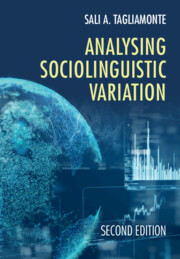Book contents
- Analysing Sociolinguistic Variation
- Analysing Sociolinguistic Variation
- Copyright page
- Dedication
- Contents
- Figures
- Tables
- Preface
- 1 Introduction
- 2 Data Collection
- 3 The Sociolinguistic Interview
- 4 Data Handling
- 5 The Linguistic Variable
- 6 Formulating Hypotheses/Operationalising Claims
- 7 Why Use Statistics?
- 8 Distributional Analysis
- 9 Exploratory Modelling
- 10 Mixed Effects Modelling
- 11 Visualisation
- 12 Interpreting and Reporting Your Results
- 13 Finding the Story
- Bibliography
- Index
1 - Introduction
Published online by Cambridge University Press: 19 June 2025
- Analysing Sociolinguistic Variation
- Analysing Sociolinguistic Variation
- Copyright page
- Dedication
- Contents
- Figures
- Tables
- Preface
- 1 Introduction
- 2 Data Collection
- 3 The Sociolinguistic Interview
- 4 Data Handling
- 5 The Linguistic Variable
- 6 Formulating Hypotheses/Operationalising Claims
- 7 Why Use Statistics?
- 8 Distributional Analysis
- 9 Exploratory Modelling
- 10 Mixed Effects Modelling
- 11 Visualisation
- 12 Interpreting and Reporting Your Results
- 13 Finding the Story
- Bibliography
- Index
Summary
This book is about doing variation analysis. My goal is to give you a manual which will take you through a variationist analysis from beginning to end. Although I will cover the major issues, I will not attempt a full treatment of the theoretical issues nor of the statistical underpinnings. Instead, you will be directed to references where the relevant points are treated fully and in detail. In later chapters, explicit discussion will be made as to how different types of analysis either challenge, contribute to, or advance theoretical issues.
Keywords
Information
- Type
- Chapter
- Information
- Analysing Sociolinguistic Variation , pp. 1 - 15Publisher: Cambridge University PressPrint publication year: 2025
